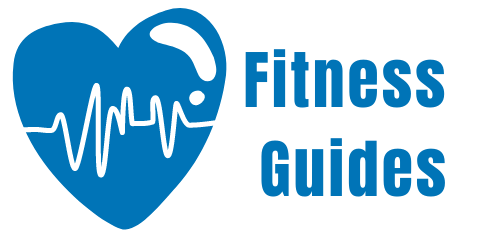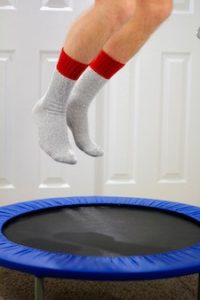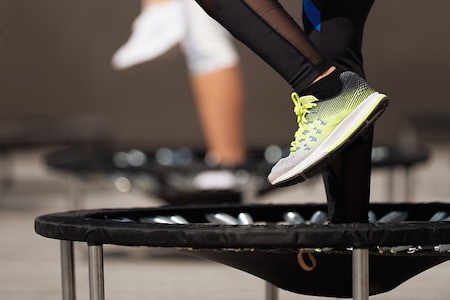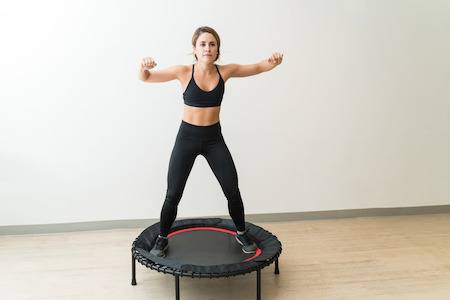Jumping on the trampoline might offer you a good aerobic training, but a rebounder is better. Rebounders are specifically designed for fitness so that their materials allow you to bounce better without hurting your joints. You can jump as fast or as slow as you need depending on your fitness level and the type of training you need.
As such, you can work your muscles, improve your stamina, and even improve your bone density. Some sources also claim that rebounding is good for detoxification as you increase your lymphatic drainage.
But can rebounding really do all that? Read more about the benefits of rebounding to find out.
Table of Contents
Top 8 Benefits of Rebounding
1. Rebounding Improves Your Aerobic Capacity
According to a 1980 study conducted through NASA, your oxygen intake is twice as big when you’re jumping on the trampoline than when you’re running on the treadmill.
This tells you that rebounding increases your aerobic capacity twice as fast than other types of cardiovascular exercises. The result is that you will have a healthier heart and lungs so that you can prevent various chronic illnesses in the long-term.
In the short term, you will find yourself feeling more energetic and better rested. That’s because your whole body gets more oxygen, not just your heart and lungs. As such, you will be more productive at work, find more energy to play with your kids, and sleep better.
Pro tip: If you want to increase your stamina and aerobic capacity faster, get a mini rebounder for HIIT training. These types of rebounders have foldable legs that allow you to build an incline plane to increase the difficulty of your workouts.
2. Rebounding Works Your Muscles Better
You can try different types of cardiovascular exercises. Walking, cycling, and swimming train your body well and are good low-impact choices. Running or HIIT burns a lot of calories, but they’re not gentle on the joints. However, it’s generally agreed that all these activities will help you increase your stamina and work out your muscles.
We argue that rebounding is better if you want a complete workout. According to that same NASA endorsed study, jumping on the trampoline increases the degree of biomechanical stimuli compared to running. Besides, rebounding can increase your external work output up to 68% more than running.
That means you will burn more calories as your muscles get a better workout. Therefore, you can reap a host of benefits, such as losing more weight and building a bigger muscle mass.
Pro tip: If you want to burn more of your fat stores and tone your muscles, even more, get a professional rebounder with added weights.
3. Rebounding Stabilises Your Core
If you’re like most people, you have a weak core. That’s nothing to be ashamed of because most people who have 9-to-5 jobs do. We tend to sit down for too long on non-ergonomic chairs so that we compromise our postures, and the result is that our core muscles are even more affected.
Most people also believe that core training should involve a lot of crunches and rarely focus on their back muscles. However, crunches may be out of the question for you depending on your fitness level or preexisting medical conditions.
Rebounding offers you an effective, low-impact way to stabilise your core so that you can correct your posture and alleviate pain. That’s because rebounding works out your deep core muscles from your abs to your lumbar area.
Another result is that you will gain more coordination and balance. A 2011 study specifically shows that rebounding is beneficial for the elderly because their balance improved considerably. Besides, you will soon be able to get to more intense workouts once you build your basic core strength.
Pro tip: If you want to increase your core strength, consider a rebounder that allows firm jumps instead of one that lets you sink too much. For instance, Maximus Life rebounders use a patented technique that builds your core strength thanks to the firm downward push, whereas most other rebounders focus on the jump.
4. Rebounding Increases Your Bone Density
Most people may not think that rebounding is the best exercise to improve bone density. After all, strength training or walking are what most doctors usually advise their patients to do so that they can increase bone density.
However, recent studies show that rebounding is one of the best types of exercise to increase bone density. If you have thyroid problems, diabetes, or other health issues, it’s wise to ask your GP about rebounding.
For instance, a 2015 study showed that dancing on a wooden floor and dancing on a mini trampoline significantly increased bone density in subjects. However, exercising on the trampoline affected the subject’s joints less and increased their muscle strength.
Besides, a 2016 study shows that people who jump on the trampoline have a bigger spine and hip bone density. So if you want to correct your posture, ask your doctor or physical therapist about getting a rebounder.
Moreover, according to another 2015 study, rebounding helped decrease chronic back pain in elderly patients who also lost their balance frequently.
Pro tip: Consider a rebounder with added weights or resistance bands to increase your bone density even more. You can also add cycling, walking, and swimming to your routine.
5. Rebounding Helps You Have a Better Sex Life
It also helps stop peeing yourself when you hear a good joke.
Incontinence and some sexual issues are caused by weak pelvic floor muscles. These muscles on the base of your pelvis are linked to your deep core muscles. However, poor posture, a sedentary lifestyle, and pregnancy weaken your pelvic floor muscles.
Rebounding stabilises your core and tones your pelvic floor muscles because it forces you to contract them while you’re jumping up and down. All you need is 20 minutes of rebounding per day to notice a difference in just a few weeks.
Pro tip: Consult your doctor especially if you have serious medical issues. Add Kegel exercises to your routine whether you’re a man or a woman, and you’ll see quick improvements in your pelvic floor strength.
6. Rebounding Doesn’t Hurt Your Joints
If you’re like most people with joint pain, you may lack the motivation to exercise because you can’t find a safe, effective workout that helps you achieve your goals quickly.
Remember that famous 1980 NASA study we told you about before? Well, the study also shows that running on the treadmill puts more pressure on your ankles than rebounding. That’s because when you’re running, the G-force on your ankles is double that measured at your back or forehead. Conversely, when you’re rebounding, the G-force is almost equal at all these three points.
That’s why rebounding is easy on your joints and won’t trigger your pain as long as you’re doing it right. Make sure to discuss with your doctor before jumping on your rebounder. You can find the right workout routine for your needs so you can build your strength and achieve your goals.
Pro tip: If you’re new to rebounding, get a rebounder that comes with a complete workout DVD or that allows you to connect to an app. That way, you can find the right routine for your needs.
7. Rebounding Increases Your Lymphatic Drainage
Rebounding makes your body oppose gravity when you’re jumping up. At the top of your jump, you’ll be in an almost weightless state for a fraction of a second. Basically, rebounding changes the way that gravitational force rhythmically affects your body.
This rhythmic change affects your lymph valves too. As such, they will open when you’re at the top of your jump and they will close when you land. This open-close movement generates an intense pump effect, which means you’re accelerating your lymphatic drainage.
As you’re doing that, your lymphatic system gets rid of more dangerous toxins and bacteria, according to Healthline. The long-term effect of this detoxifying flush is that you’re strengthening your immune system so that you can fight chronic illness better.
Pro tip: Make sure you get the right rebounder for lymphatic drainage. if you want to see faster effects, focus on jumping higher and landing lower.
8. Rebounding is FUN
As you exercise, your brain releases endorphins that make you feel good. Besides, after you’ve been rebounding for some time, you will notice significant improvements in your health and mood, and that will also make you feel happier.
And don’t forget that rebounding involves jumping. What better way to forget all your problems and squeeze in a few minutes for yourself?
In Conclusion
Rebounding has a lot of benefits. It helps you get stronger, healthier, and leaner. You will sleep better, feel happier, and enjoy your sex life more.
So if you’re up for a challenge that’ll get you jumping, you should definitely buy one.
- At What Incline Should You Walk on a Treadmill? - August 29, 2022
- 7 Best Budget Exercise Bikes (under £200) - April 5, 2022
- 6 Best Compact Treadmills for Small Spaces - April 5, 2022



